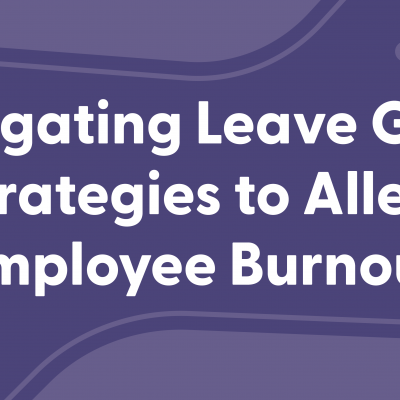You can put down your compass and there’s no sense in having Google Maps try to guide you, because when it comes to optimizing workforce planning in the wake of employee leaves of absence, minimizing employee burnout requires a special kind of navigation.
So what is employee burnout exactly? And why is it more important than ever that employers take its impact on employee wellbeing and operational effectiveness seriously? “Burnout” is a term that can mean a lot of different things to a lot of different people, for some so let’s just take the medical definition and go from there:
“Burnout is a psychological syndrome emerging as a prolonged response to chronic interpersonal stressors on the job. The three key dimensions of this response are an overwhelming exhaustion, feelings of cynicism and detachment from the job, and a sense of ineffectiveness and lack of accomplishment.
The significance of this three‐dimensional model is that it clearly places the individual stress experience within a social context and involves the person’s conception of both self and others.”
In other words, if your employees have been engaged to the max for a prolonged period of time without organizational support, and they don’t have the individual skills to manage that stress, burnout becomes an eventuality, not a potentiality.
Therefore it shouldn’t be surprising that 40% of employees cite burnout as a reason to leave an employer, but the common approaches to minimizing employee burnout tend to focus on the individual, their work-life balance, and making self-help stress mitigation accessible.
While holding walking meetings may be beneficial in the short term, strategies that focus on the symptom and not the root cause are akin to sitting in a leaking boat and trying to tape up the holes as new ones form.
Eventually, you’re going to sink.
The data backs this up as well, as nearly 70 percent of professionals in a recent Deloitte survey stated that they feel their employers are not doing enough to prevent or alleviate burnout within their organization. 21 percent of respondents say their company does not offer any programs or initiatives to prevent or alleviate burnout.
So how does your employee leave of absence process affect your organization’s susceptibility to burnout? How can a more modern approach to leave of absence management help solidify the foundational support your organization provides?
Is Your Leave of Absence Process Leading to Employee Burnout?
It may be intuitive to assume that having robust leave-of-absence policies would lead to a reduction in employee burnout, not an increase. And to be crystal clear, you should absolutely fight tooth and nail to provide the most robust leave policies to your people, but an employee leave of absence is unlike most employee benefits in that the ripple effect of an employee taking leave extends beyond the employee taking leave and you in People Ops trying your best to administer it.
The single leave of absence, say for a disability, parental, or bereavement leave, creates a gap in workforce productivity in that employee’s wake. Where there’s a gap in productivity,\ due to an employee taking leave, that employee’s manager and the colleagues who remain are often left filling in that gap.
If you’re manually administering leaves of absence today, or you’re currently using a hodgepodge of systems and spreadsheets for tracking and administering your leaves, your organization is likely stuck trying to navigate a needed shift in workforce planning without the necessary visibility to do so.
When you and an employee’s manager don’t have the same visibility into their leave of absence (which can have details like start and end dates change at a moment’s notice), you run the risk of workforce planning blind.
The ramifications of workforce planning without proper visibility range from becoming susceptible to overburdening the employees left to pick up the slack of the employee on leave, and to hurting the bottom line by not delivering on promises to clients.
“Leave coverage is extremely important,” says Tilt COO Kait Keeney, “because the employee needs to focus on what matters most, while others in their work orbit need to continue the essential work of the business. The only way to ensure things don’t go totally sideways is a solid leave plan and process.”
The policies you have in place to support your employees who need to take time away from work when life happens hardest are one very important part of the employee burnout equation, but if your organization isn’t in a position to effectively navigate workforce gaps when a leave pop up, your organization is still at risk of inducing employee burnout to the others.
Leave of Absence Strategies to Alleviate Burnout
It might seem reductive to put it this way, but one of the most effective ways to bring visibility into your workforce planning, and to reduce the potential for burnout when a leave is requested, is to remove the blindspots you have.
Cool, so…like how do you do that?
Well, the truth is that the traditional way of managing leaves of absence makes workforce coverage a casualty of capacity. If you had the time to accurately and regularly update employee leave data in your spreadsheets, and if you could streamline communications compliantly (friendly reminder that managers are NOT leave experts and can communicate their way into fines for your organization) to ensure that you, the employee and the manager were always in the know, then you could make a valiant attempt to provide the visibility necessary to workforce plan, mitigate burnout, and keep your organizational objectives on track.
Doing that well for a single leave of absence is a daunting task, and as we all know, leaves of absence are unpredictable in their nature and occurrence. You might have to workforce plan for the gap created by one leave of absence today, and three tomorrow.
Dedicated Leave Management Software: An effective way to remove workforce planning blindspots and create visibility into your leave of absence process is with dedicated leave management software.
The right dedicated leave management software does more than alleviate your administrative burdens so you can focus on other elements of the job you enjoy. It also can create a connective synergy between People Ops, the employee, and the employee’s manager, giving everyone real-time information on a given leave so that workforce planning can be implemented with confidence and efficiency.
A proper dedicated leave management software automates leave tracking in real-time for better visibility into your organization’s workforce needs. It also can remove data inconsistencies due to manual data entry, and consolidate any siloed systems into one source of truth that your organization can work from to workforce plan, keep burnout low, and continue delivering to your clients without disruption.
Hire Temporary Workers: Just like leaves of absence, no two organizations are alike. As such, it might not be so easy for you to shift workers around or cross-train employees to cover gaps. That’s where temporary workers might be your ally in covering workforce gaps due to leaves of absence.
“If you want to have a successful leave experience using temporary or part-time workers can work really well,” says Kait. “It’s a great way to build a pipeline of future FTEs and support the employee on leave, and also avoid the teammate gripes or resentment that may brew if others feel they’ve just inherited a whole bunch of work without any support.”
If you are in a position to cross-train employees, it can be a growth opportunity for others to gain new skills, see different sides of the business, and help out.
Have a Reboarding Plan: A large focus of this article has been on the burnout employees may face trying to fill in the workforce gaps due to a leave of absence, but the employee on leave can experience burnout when they return as well if the workload hasn’t been effectively dispersed in their absence.
“Having a re-onboarding plan is very important,” adds Kait, “especially for those extended leaves when someone has been out for a long time. Just like you would onboard a new hire, have a plan for welcoming employees coming back from leave. ‘ICYMI docs,’ are helpful for when employees return so that they can digest in their own time and ask questions as needed. It isn’t just this ‘hey, welcome back…’ followed by an overwhelming verbal diarrhea of all they missed while they were out.”
There’s a chance your employee has just gone through a leave journey that has changed their life both inside and outside of work forever. Being empathetic to their experience and providing a soft and supported environment for them to land after a leave of absence can do wonders to mitigate a sometimes whiplash-like experience of being thrown back into the fire.
Your Leave of Absence Approach is Foundational to Employee Support
Whether you cross-train employees or leverage temporary/part-time workers to fill in workforce gaps due to a leave of absence, effectively managing your leaves of absence using modern technology creates the visibility required to effectively and efficiently move the necessary pieces in place so that employee workloads aren’t overflowing and managers are able to deliver on their organizational goals.
Operational inefficiencies due to a lack of visibility into leave of absence details can overstress your workforce, leading to a boost in burnout levels and ultimately a potential retention reckoning.
Invest in the right tools to make the seamless navigating of leave gaps a foundational part of your employee support process, cross-train and be prepared to hire temporary employees if necessary, and be mindful of employees returning from leave and their susceptibility to burnout.
About Tilt
Tilt is leading the charge in all things leave of absence management through easy-to-use tech and human touch. Since 2017, our proprietary platform and Empathy Warriors have been helping customers make leave not suck by eliminating administrative burdens, keeping companies compliant, and providing a truly positive and supportive leave of absence experience for their people.







